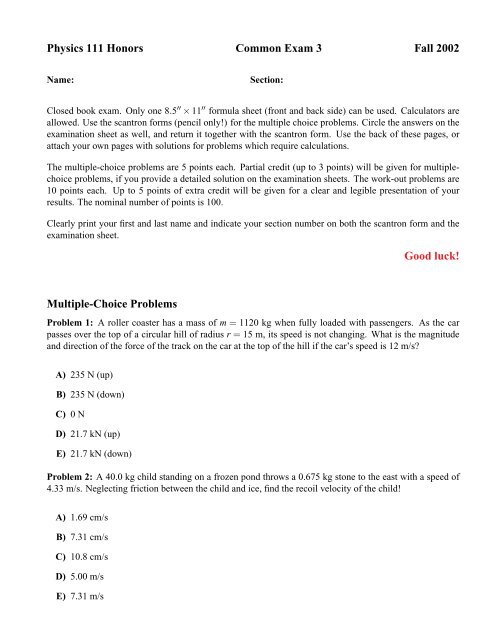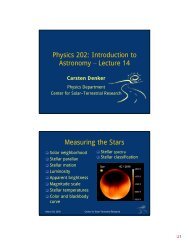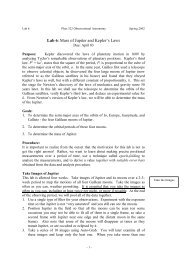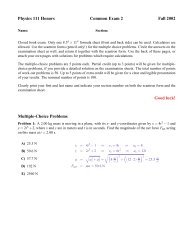3rd Common Quiz (empty)
3rd Common Quiz (empty)
3rd Common Quiz (empty)
Create successful ePaper yourself
Turn your PDF publications into a flip-book with our unique Google optimized e-Paper software.
Physics 111 Honors <strong>Common</strong> Exam 3 Fall 2002<br />
Name: Section:<br />
Closed book exam. Only one 8.5 ′′ × 11 ′′ formula sheet (front and back side) can be used. Calculators are<br />
allowed. Use the scantron forms (pencil only!) for the multiple choice problems. Circle the answers on the<br />
examination sheet as well, and return it together with the scantron form. Use the back of these pages, or<br />
attach your own pages with solutions for problems which require calculations.<br />
The multiple-choice problems are 5 points each. Partial credit (up to 3 points) will be given for multiplechoice<br />
problems, if you provide a detailed solution on the examination sheets. The work-out problems are<br />
10 points each. Up to 5 points of extra credit will be given for a clear and legible presentation of your<br />
results. The nominal number of points is 100.<br />
Clearly print your first and last name and indicate your section number on both the scantron form and the<br />
examination sheet.<br />
Multiple-Choice Problems<br />
Good luck!<br />
Problem 1: A roller coaster has a mass of m = 1120 kg when fully loaded with passengers. As the car<br />
passes over the top of a circular hill of radius r = 15 m, its speed is not changing. What is the magnitude<br />
and direction of the force of the track on the car at the top of the hill if the car’s speed is 12 m/s?<br />
A) 235 N (up)<br />
B) 235 N (down)<br />
C) 0 N<br />
D) 21.7 kN (up)<br />
E) 21.7 kN (down)<br />
Problem 2: A 40.0 kg child standing on a frozen pond throws a 0.675 kg stone to the east with a speed of<br />
4.33 m/s. Neglecting friction between the child and ice, find the recoil velocity of the child!<br />
A) 1.69 cm/s<br />
B) 7.31 cm/s<br />
C) 10.8 cm/s<br />
D) 5.00 m/s<br />
E) 7.31 m/s
Problem 3: A disk of radius R has been stamped out (removed) from a uniform metal plate P of radius 2R.<br />
Using the xy-coordinate system shown, locate the center of mass (xp,yp) of the plate.<br />
A) (xp = 0,yp = 0)<br />
B) (xp = 0,yp = 1 4 R)<br />
C) (xp = 1 4 R,yp = 0)<br />
D) (xp = 1 3 R,yp = 0)<br />
E) (xp = 2 5 R,yp = 0)<br />
Problem 4: Three thin rods, each of length L, are arranged in an inverted U. The two rods on the arm of<br />
the U have mass M and the third rod has the mass 3M. Where is the center of mass of the assembly for the<br />
vertical component ycom as measured from the third rod.<br />
A) ycom = 1 5 L<br />
B) ycom = 2 5 L<br />
C) ycom = 3 5 L<br />
D) ycom = 1 3 L<br />
E) ycom = 2 3 L<br />
Problem 5: A pitched 140 g baseball, in horizontal flight with a speed vi = 42.0 m/s, is struck by a bat.<br />
After leaving the bat, the ball travels in opposite direction with a speed, also v f = 42.0 m/s. If the average<br />
force during the impact is Favg = 10.0 kN, what is impact time Δt for the baseball/bat collision?<br />
A) 0.588 ms<br />
B) 1.18 ms<br />
C) 4.20 ms<br />
D) 8.40 ms<br />
E) 10.0 ms
Problem 6: A bullet (mb = 9.78 g) is fired into a stationary block of wood (mw = 4.52 kg), coming quickly<br />
to rest inside the block. The speed of the bullet/wood combination after the collision is 0.512 m/s. What<br />
was the original speed of the bullet?<br />
A) 11 m/s<br />
B) 121 m/s<br />
C) 237 m/s<br />
D) 335 m/s<br />
E) 463 m/s<br />
Problem 7: A steel ball of mass 0.436 kg is fastened to a cord that is 0.875 m long and fixed at the far end.<br />
The ball is then released when the cord is horizontal. At the bottom of the path, the ball strikes a 3.25 kg<br />
steel block initially at rest on a frictionless surface. The collision is elastic. Find the speed of the block after<br />
the collision!<br />
A) 0.490 m/s<br />
B) 0.693 m/s<br />
C) 0.980 m/s<br />
D) 1.11 m/s<br />
E) 7.31 m/s<br />
Problem 8: Which of the following statements is false?<br />
A) A collision is an isolated event in which two or more bodies (the colliding bodies) exert relatively<br />
strong forces on each other for a relatively short time.<br />
B) In a closed isolated system containing a collision, the linear momentum of each colliding body may<br />
change but the total linear momentum P of the system cannot change, whether the collision is elastic<br />
or inelastic.<br />
C) If no net external force acts on a system of particles, the total linear momentum P of the system<br />
cannot change.<br />
D) In an elastic collision, the kinetic energy of each colliding body may change, but the total kinetic<br />
energy of the system does not change.<br />
E) The linear momentum P of a system of particles is equal to the product of the total mass M and the<br />
acceleration of the center of mass acom.
Problem 9: A rigid sculpture consists of a thin hoop of mass mhoop = 1.25 kg and radius Rhoop = 0.15 m<br />
and a thin radial rod of mass mrod = 0.68 kg and length Lrod = 2Rhoop. The sculpture can pivot around a<br />
horizontal axis in the plane of the hoop passing through its center. What is the sculptures rotational inertia<br />
I about the rotation axis?<br />
A) 2.8 × 10 −1 kg m 2<br />
B) 5.3 × 10 −1 kg m 2<br />
C) 1.5 × 10 −2 kg m 2<br />
D) 4.1 × 10 −2 kg m 2<br />
E) 8.0 × 10 −2 kg m 2<br />
Problem 10: A cylinder having a mass of 3.5 kg can rotate about its central axis through point O Four<br />
forces are applied as shown: F1 = 4.5 N, F2 = 3.4 N, F3 = 1.7 N, and F4 = 4.9 N. The radial distances are<br />
R1 = 13 cm and R2 = 28 cm, respectively. Find the magnitude and direction of the angular acceleration of<br />
the cylinder.<br />
A) 0.087 rad/s 2 (clockwise)<br />
B) 0.63 rad/s 2 (clockwise)<br />
C) 0 rad/s 2<br />
D) 0.63 rad/s 2 (counter-clockwise)<br />
E) 0.087 rad/s 2 (counter-clockwise)
Work-Out Problems<br />
Please indicate your final answers and make sure that all the steps of your solution are shown!<br />
Problem A: Two cars with the same mass are involved in an accident. Car A was travelling East and car<br />
B South before the collision. Assume that the accident is an inelastic collision. In what direction, will the<br />
wreckage of the cars move after the collision, if the initial speed of car A is 2.24 times that of car B?<br />
Problem B: A proton of mass 1.0 u moving in the positive x-direction with an initial velocity vpix collides<br />
elastically with an α-particle of mass 4.0 u that is initially at rest. After the collision, the proton moves in<br />
the negative y-direction.<br />
a) Provide a sketch!<br />
b) What is the speed of the proton after the collision vp f y in terms of vpix?<br />
c) What is the speed of the α-particle after the collision vα f in terms of vpix?<br />
d) What is the angle θ between proton and α-particle after the collision?
Problem C: Ramon Unzaga, from Spain, is credited to have performed the first bicycle kick in 1914, and<br />
Pelé made it world famous in the 60s and 70s. The figure shows an analysis of a Pelé’s bicycle kick. Main<br />
phases of the bicycle kick: the jumping (1), the scissors (2), and the ball striking (3). (a) Vertical position<br />
of the center of gravity CG of the whole body and (b) only of the trunk. (c) Angular position of the legs.<br />
(d) Rotational inertia of the kicking leg. (e) The angular momentum of the whole body and of each leg.<br />
a) How long does it take to perform the bicycle<br />
kick?<br />
b) How long is the soccer player in the air?<br />
c) What are the laws of physics that describe the<br />
position of the center of mass?<br />
d) The angular momentum L = Iω of the whole<br />
body is almost constant during the aerial phase.<br />
How does the soccer player achieve an effective<br />
kick so that the ball obtains a high velocity?<br />
e) When is the inertia of the kicking leg a minimum?<br />
What does that mean for the angular<br />
acceleration and the kinetic energy associated<br />
with the rotation?<br />
f) Is the angular momentum conserved during the<br />
kick?
Problem D: If Icom is the rotational inertia of a body about a parallel axis that extends through the body’s<br />
center of mass, and h is the perpendicular distance between the given axis and the axis through the center<br />
of mass, then the rotational inertia I about the given axis is<br />
I = Icom + Mh 2 ,<br />
where M is the total mass of the body. This equation is known as the Parallel-Axis Theorem. Please show<br />
the proof of the parallel-axis theorem! Provide a clear sketch in an appropriate coordinate system, clearly<br />
indicate all your variables, and explain every step of the proof.<br />
Problem E: Some modern hybrid cars use a flywheel to store kinetic energy. The car has a mass of 1500 kg<br />
and decelerates from 40 km/h to a full stop in 4.5 s. The flywheel consists of an annular cylinder of mass<br />
33.0 kg with inner radius r1 = 0.1 m and outer radius r2 = 0.2 m.<br />
a) What is the initial kinetic energy of the car?<br />
b) What is the rotational inertia of the flywheel?<br />
c) Assume that the kinetic energy is conserved during the deceleration, what is the angular velocity of<br />
the flywheels rotation in revolution per second?<br />
d) What is the angular acceleration of the flywheel during the deceleration of the car in revolutions per<br />
second 2 ? (Assume that the angular acceleration is constant and that the flywheel was not rotating<br />
when the car started to break).<br />
Before you turn in your quiz, please double-check you multiple-choice answers. Are they marked<br />
correctly on the scantron form? Don’t forget to use the correct units in the work-out problems!
















